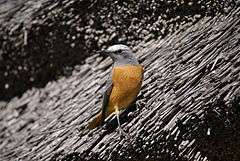Rock thrush
| Rock thrushes | |
|---|---|
 | |
| Male short-toed rock thrush, Monticola brevipes | |
| Scientific classification | |
| Kingdom: | Animalia |
| Phylum: | Chordata |
| Class: | Aves |
| Order: | Passeriformes |
| Family: | Muscicapidae |
| Genus: | Monticola F. Boie, 1822 |
| Type species | |
| Turdus saxatilis Linnaeus, 1766 | |
| Species | |
|
13, see text | |
| Synonyms | |
| |
The rock thrushes, Monticola, are a genus of chats, medium-sized mostly insectivorous or omnivorous songbirds. All are Old World birds, and most are associated with mountainous regions.
Taxonomy
The genus was erected by the German naturalist Friedrich Boie in 1822.[1][2] Monticola is the Latin word for mountain-dweller or mountaineer.[3] The genus was formerly included in the thrush family Turdidae.[4] Molecular phylogenetic studies published in 2004 and 2010 showed that the species are more closely related to members of the Old World flycatcher family Muscicapidae.[5][6]
The genus contains the following species:[7]
- White-winged cliff chat, Monticola semirufus (formerly in Thamnolaea)[8]
- Cape rock thrush, Monticola rupestris
- Sentinel rock thrush, Monticola explorator
- Short-toed rock thrush, Monticola brevipes
- Miombo rock thrush, Monticola angolensis
- Common rock thrush, Monticola saxatilis
- Little rock thrush, Monticola rufocinereus
- Blue rock thrush, Monticola solitarius
- Chestnut-bellied rock thrush, Monticola rufiventris
- Blue-capped rock thrush, Monticola cinclorhynchus
- White-throated rock thrush, Monticola gularis
- Littoral rock thrush, Monticola imerinus
- Forest rock thrush, Monticola sharpei
- Benson's rock thrush, Monticola sharpei bensoni
- Amber Mountain rock thrush Monticola sharpei erythronotus
Fossil record
Monticola pongraczi (Pliocene of Beremend, Hungary) [9]
References
- ↑ Mayr, Ernst; Paynter, Raymond A. Jr. (1964). Check-list of Birds of the World. Volume 10. Cambridge, Massachusetts: Museum of Comparative Zoology. p. 135.
- ↑ Boie, F. (1822). "Ueber Classification, insonderheit der europäischen Vogel". Isis von Oken (in German). 10-11. Col. 552.
- ↑ Jobling, James A. (2010). The Helm Dictionary of Scientific Bird Names. London: Christopher Helm. p. 260. ISBN 978-1-4081-2501-4.
- ↑ Dickinson, E.C., ed. (2003). The Howard and Moore Complete Checklist of the Birds of the World (3rd ed.). London: Christopher Helm. ISBN 978-0-7136-6536-9.
- ↑ Voelker, G.; Spellman, G.M. (2004). "Nuclear and mitochondrial DNA evidence of polyphyly in the avian superfamily Muscicapoidea". Molecular Phylogenetics and Evolution. 30: 386–394. doi:10.1016/S1055-7903(03)00191-X.
- ↑ Sangster, G.; Alström, P.; Forsmark, E.; Olsson, U. (2010). "Multi-locus phylogenetic analysis of Old World chats and flycatchers reveals extensive paraphyly at family, subfamily and genus level (Aves: Muscicapidae)". Molecular Phylogenetics and Evolution. 57 (1): 380–392. doi:10.1016/j.ympev.2010.07.008.
- ↑ Gill, Frank; Donsker, David (eds.). "Chats, Old World flycatchers". World Bird List Version 6.2. International Ornithologists' Union. Retrieved 20 May 2016.
- ↑ Zuccon, D.; Ericson, Per G.P. (2010). "The Monticola rock-thrushes: phylogeny and biogeography revisited". Molecular Phylogenetics and Evolution. 55: 901–910. doi:10.1016/j.ympev.2010.01.009.
- ↑ Kessler, E. 2013. Neogene songbirds (Aves, Passeriformes) from Hungary. – Hantkeniana, Budapest, 2013, 8: 37-149.
Further reading
- Outlaw, R.K.; Voelker, G.; Outlaw, D.C. (2007). "Molecular systematics and historical biogeography of the Rock-thrushes (Muscicapidae: Monticola)". The Auk. 124 (2): 561–577. doi:10.1642/0004-8038(2007)124[561:MSAHBO]2.0.CO;2.

External links
| Wikimedia Commons has media related to Monticola. |
- Rock thrush videos on the Internet Bird Collection
This article is issued from Wikipedia - version of the 10/19/2016. The text is available under the Creative Commons Attribution/Share Alike but additional terms may apply for the media files.